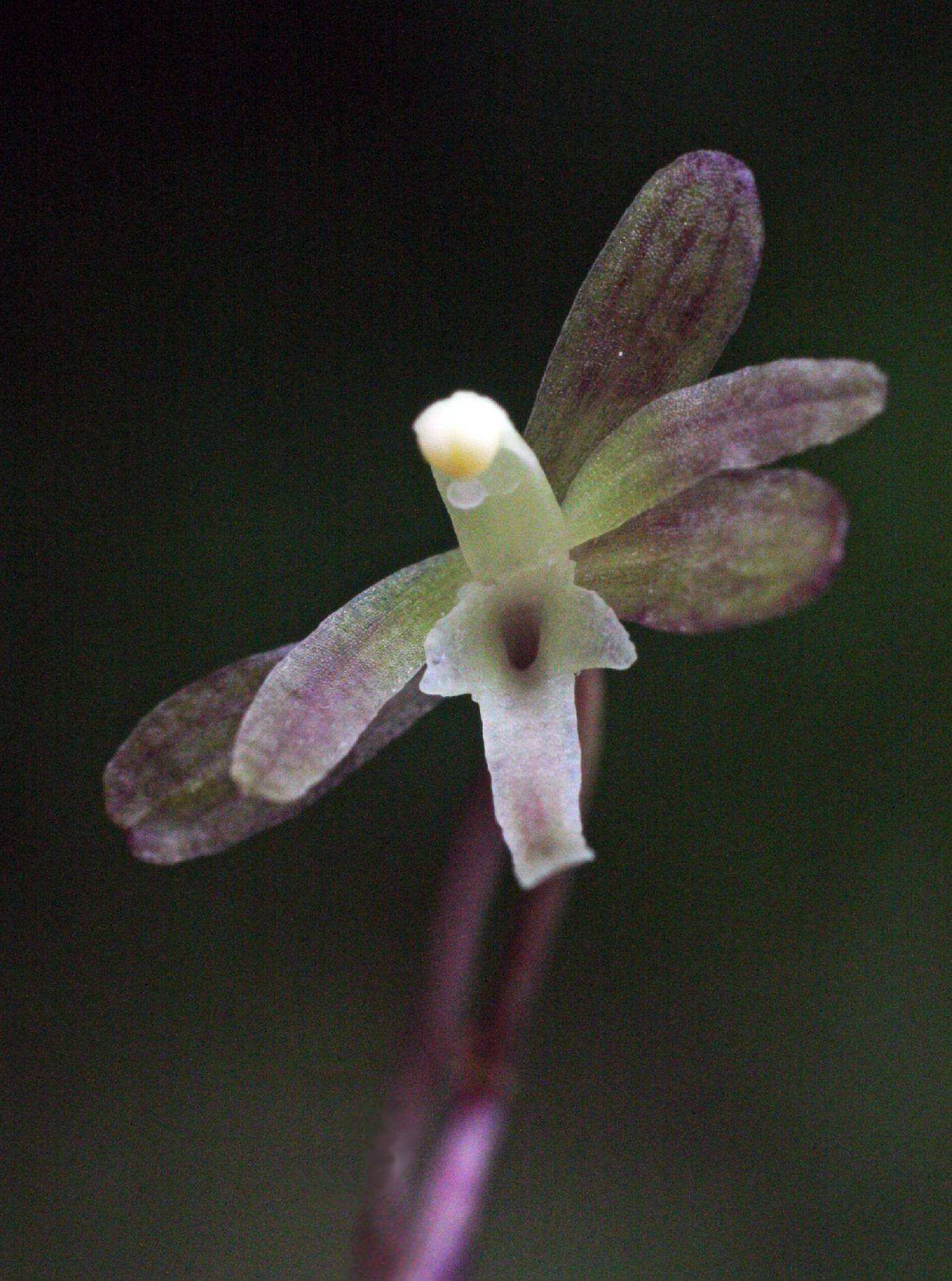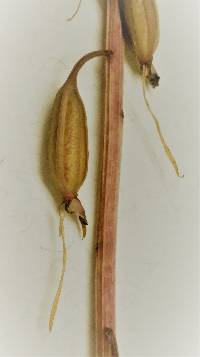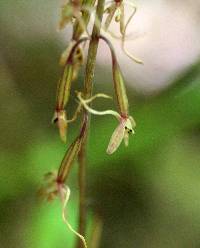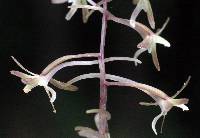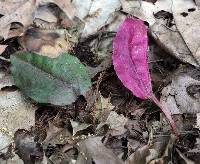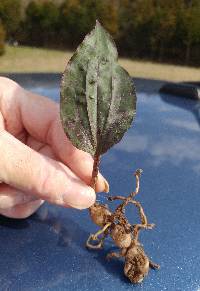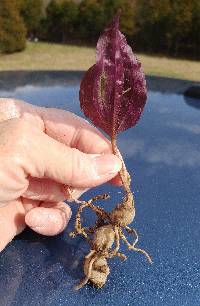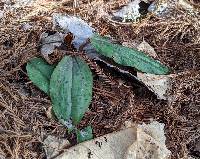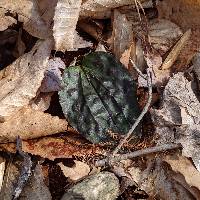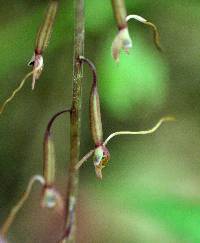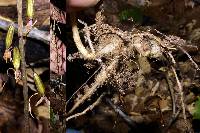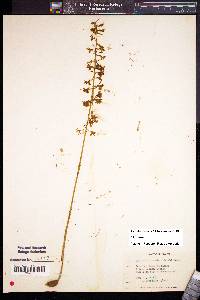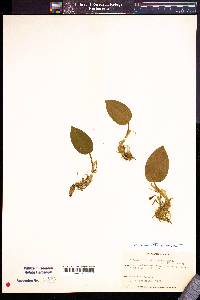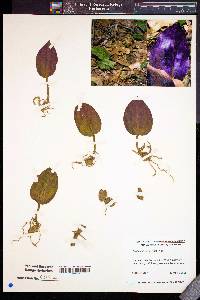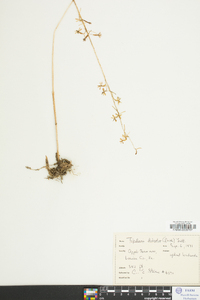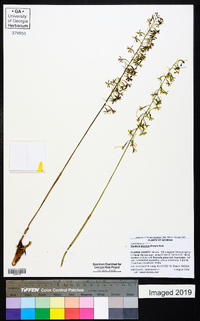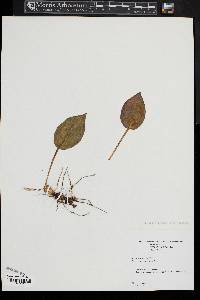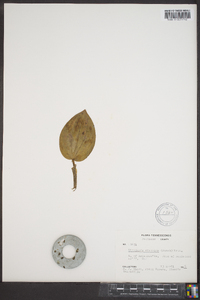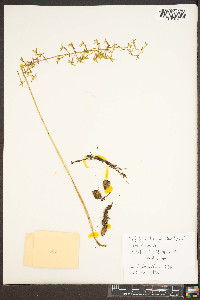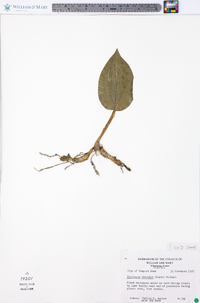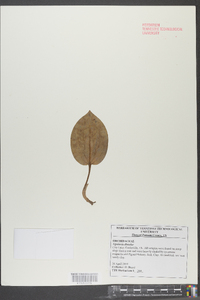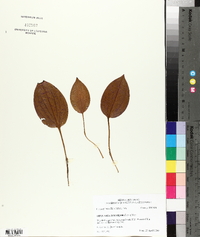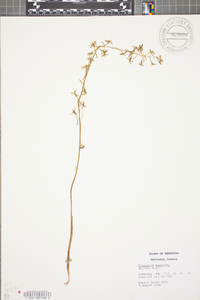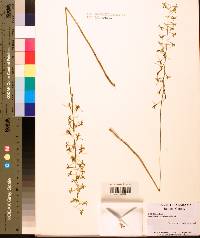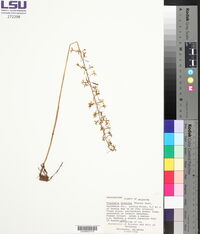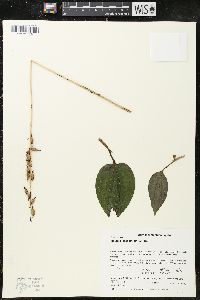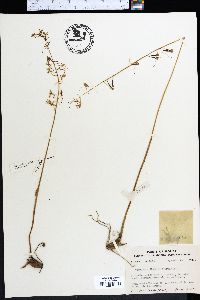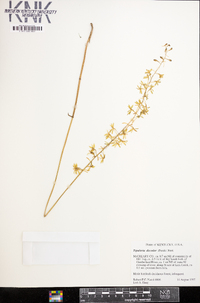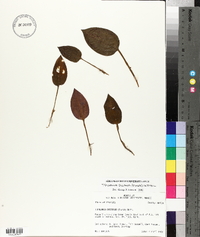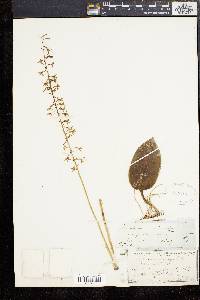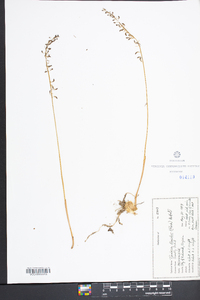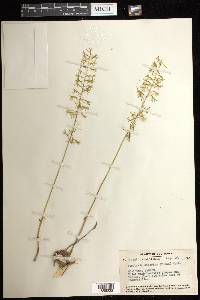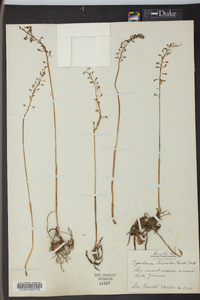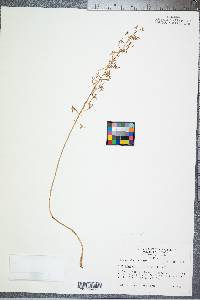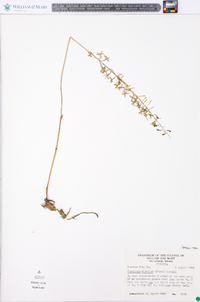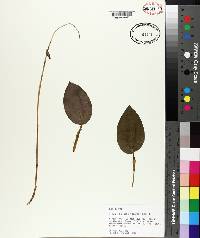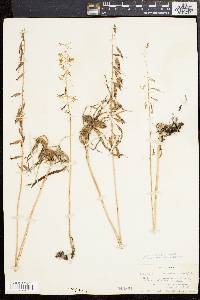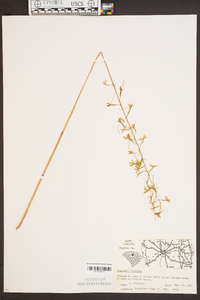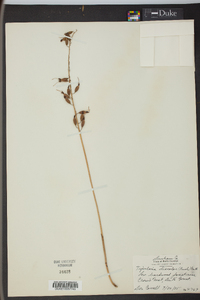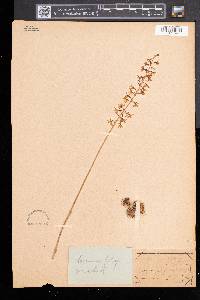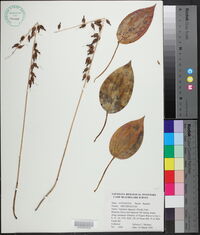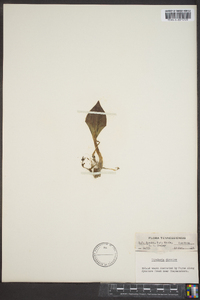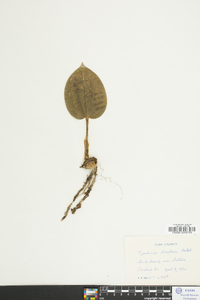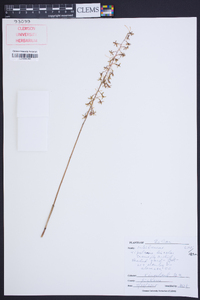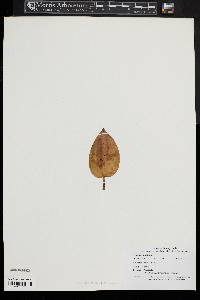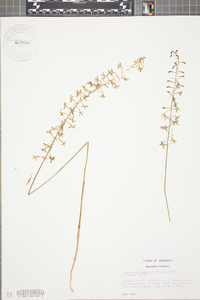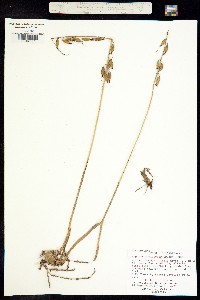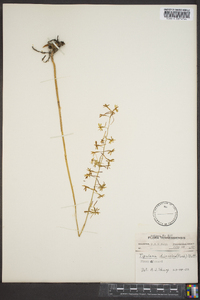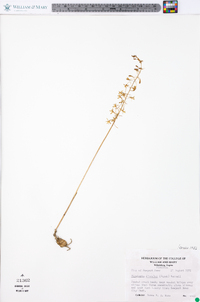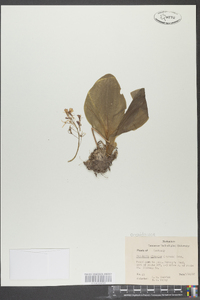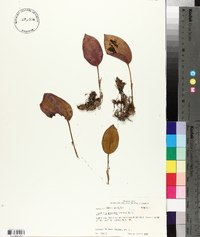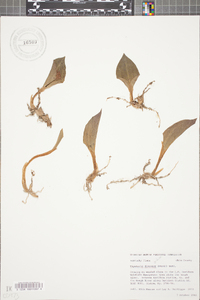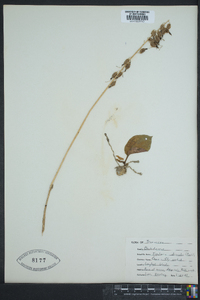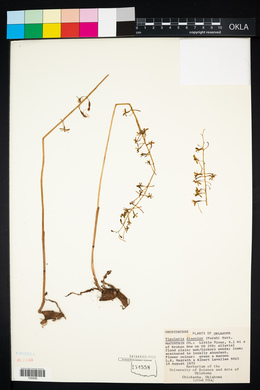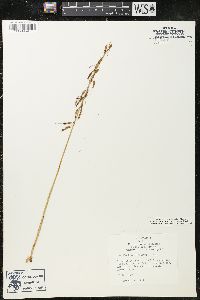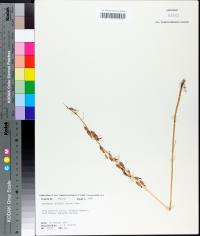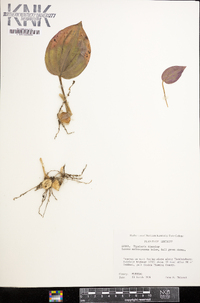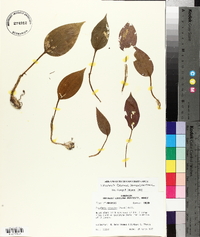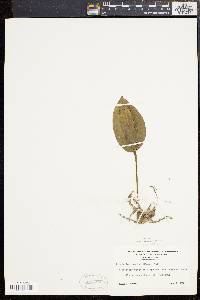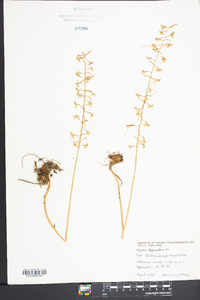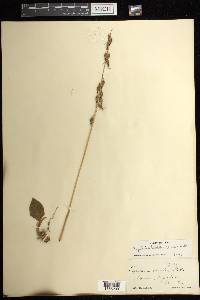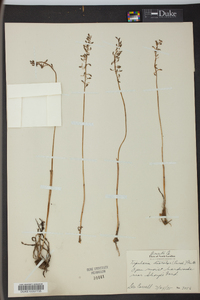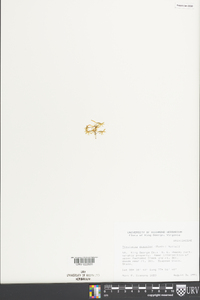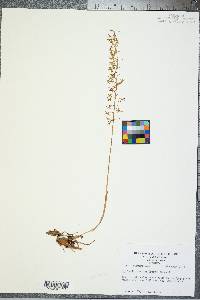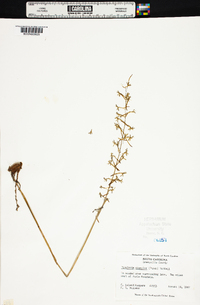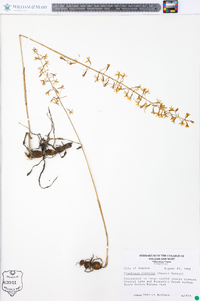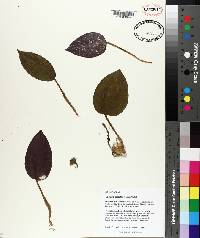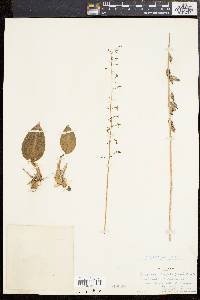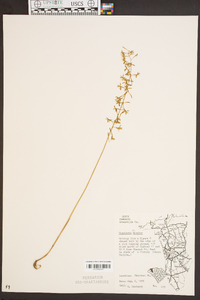Tipularia discolor
|
|
|
|
Family: Orchidaceae
Crippled-Cranefly
|
Plants 10-65 cm. Corms 7-30 (-50) mm diam. Stems scapose, glabrous, basally 1-2-sheathed. Leaves persisting over winter; petioles 3-15 cm; blade purple abaxially, green or greenish purple adaxially, ovate, 5-10.5 × 2.5-7 cm. Inflorescences 8-28 cm; floral bracts 0.2 mm. Flowers green, pale greenish yellow, or greenish purple, (5-)10-55; sepals distinct and free, oblong-elliptic to oblanceolate, 5-8 × 1.5-2.8 mm; petals linear-oblong to oblong-elliptic to linear-oblanceolate, 4-7 × 1-1.8 mm; lip 5-8 × 2.5-3 mm, with 2 prominent basal lobes, spur 10-23 mm; column 2.5-4 mm. Capsules 9-12 × 4-5 mm. Flowering Jun (north)--Sep (south). In humus-rich soil of deciduous woodlands; frequently in sandy, acid oak-pine woods of Southeast, often in depressions under sweet gum; 0--1000 m; Ala., Ark., Del., Fla., Ga., Ill., Ind., Ky., La., Md., Mass., Mich., Miss., Mo., N.J., N.Y., N.C., Ohio, Okla., Pa., S.C., Tenn., Tex., Va., W.Va. Tipularia discolor is pollinated by noctuid moths, the pollinaria attaching to either the left or right compound eye depending on whether the column of a particular flower is slightly twisted to the left or to the right (W. P. Stoutamire 1978). Tipularia unifolia Britton, Sterns & Poggenberg is an illegitimate name.
Perennial herb 15 - 60 cm tall Inflorescence: a single, erect, terminal, long-stalked, elongate (8 - 28 cm long), somewhat loose, spike-like cluster of twenty to fifty stalked flowers with each flower subtended by a minute, difficult to see bract. The flowers are randomly angled to one side of the main axis, with some angled to the right, others to the left, and giving the appearance of small insects hovering around the stem. Flowers: whitish or pale greenish yellow to pale purple, small (2 -3 cm long), not symmetric, but lopsided, with one petal formed into a lip and its base modified into a slender, long, purplish to green nectar spur. Rather than the typical bilaterally symmetric orchid flower, these have an unequal number of sepals and petals positioned on either side of the central fused reproductive parts of stamens, stigma and style (column). Sepals: three, spreading, petal-like, pale purplish, 4 - 8 mm long, 1.5 - 3 mm wide, oblong or oblong-elliptic to inversely lance-shaped, but with blunt tips. Petals: three, with upper two spreading, pale purple, 4 - 7 mm long, 1 - 1.8 mm wide, oblong-elliptic. The central lip petal is translucent to pale purple, 4 - 8 mm long, 1 - 3 mm wide, three-lobed with two short, pointed, lateral lobes, and a long, narrowly lance-shaped central lobe with a slightly expanded tip. Base of lip extends backwards into an obvious, 1.3 - 2 cm long (well beyond ovary), narrow (0.5 - 1 mm wide), tubular spur. Fruit: numerous, stalked, normally drooping, 0.9 - 1.2 cm long, 4 - 5 mm wide, elliptic capsules with lengthwise ribs, column remnants, and the persistent spur at the apex. Flowering stem: single, erect, purplish brown, slender, hairless, lacking leaves, but with one or two sheaths near the base. This leafless structure terminated by flowers is called a scape and technically is not a true stem. Root system: of fleshy true roots attached to a series of two or three, whitish, 0.7 - 3 cm diameter bulb-like structures (corms, technically a shoot or stem). Leaf: solitary, basal, stalked (3 - 15 cm long stalk), egg-shaped to wide elliptic, 5 - 10 cm long, 3 - 8 cm wide, non-toothed, but wrinkled or warty. The dark green upper leaf surface is typically covered with randomly scattered dark purple to brownish raised blotches of various sizes, while the dark wine-purple lower surface is dimpled. New leaves emerge in September, remain green and photosynthetic over winter, begin to wither in spring, and disappear before flowering. Similar species: The only species of Tipularia in North America, T. discolor is probably most similar to Aplectrum hyemale since both species have a single green leaf present in winter. However A. hyemale blooms earlier (spring), its flowers do not have a spur, the leaf is normally present at flowering time, the upper leaf surface has obvious white veins and no dark blotches, the underside of the leaf is only lightly tinted with purple, and the leaves are pleated lengthwise. Flowering: July to August Habitat and ecology: One of the rarest orchids in the Chicago Region, only known from two of the eastern counties: one locale in La Porte Co., IN in a mesic, sandy flatwoods dominated by red oak and scattered paper birch; and in Berrien Co., MI in rich mixed beech-maple forests. This species seems to prefer acidic soils, and in our area is often found in deep leaf mould. Occurence in the Chicago region: native Notes: There are only three species of Tipularia worldwide, and only one in North America. This genus is unique since the pollen packets (pollinia) and associated structures (collectively called pollinarium) retain the anther-cap after the pollinating nocturnal moths (millers), remove the unit from the column. This promotes outcrossing since the anther-cap does not fall away for at least eight minutes after attachment, by which time the moth is likely to be at a new plant (Homoya 1993). Etymology: Tipularia is a reference to a flying insect, the crane-fly, in the genus Tipula, which reflects the similarity in appearance between the crane-fly and this orchid's flowers. Discolor means different colors or faded, which may refer to the dull, faded color of the flower, or possibly the differences in color between the upper and lower leaf surfaces. Author: The Field Museum Lf basal, 5-10 נ2.5-7 cm, somewhat plicate, green above, purplish beneath, on a 5 cm petiole, withering in the spring; scape produced in midsummer, 2-5 dm, very slender; infl 1-2 dm; fls many; sep and lateral pet 4-8 mm, pale greenish-purple with purple veins, spreading, one pet overlapping the dorsal sep; lip pale purple, 4-8 mm, its basal lobes nearly semicircular, erose, with forwardly directed tip, the terminal lobe linear, arcuate, its margins revolute, the apex minutely notched; spur 15-22 mm; column 3-4 mm; fr pendulous. Rich damp woods; se. Mass. and s. N.Y. to s. Mich., s. to Fla. and e. Tex. June-Aug. (T. unifolia) Gleason, Henry A. & Cronquist, Arthur J. 1991. Manual of vascular plants of northeastern United States and adjacent Canada. lxxv + 910 pp. ©The New York Botanical Garden. All rights reserved. Used by permission. From Flora of Indiana (1940) by Charles C. Deam This species is restricted to our southern counties but it may have a wider range than the map shows. I have a memorandum that I saw it in Brown County but I did not preserve specimens. In 1938 Benjamin W. Douglass wrote me he found it near Trevlac. The leaves disappear before flowering time and look much like those of Orchis spectabilis or those of Aplectrum hyemale. Tipularia may easily be distinguished because the lower surface is purplish instead of green. One does not usually collect leaf specimens but in this species a leaf specimen makes a record as authentic as a flowering one. I am of the opinion that it will be found all over the unglaciated area, but very locally. Where it is found it is usually somewhat frequent but it is so inconspicuous that it may be overlooked. It grows in deep humus on protected slopes with beech or white oak and in black and white oak woods. …… Indiana Coefficient of Conservatism: C = 4 Wetland Indicator Status: FACU |
|
|
|

